Introduction
The study of exchanged materials is the basis of any archaeological study of trade. They make it possible to reconstitute the networks and their chronology. In the case of the maritime silk routes, East–West connections during the Roman period can be considered one of the best studied topics that benefitted from thoroughly investigated texts such as the Periplus Maris Erythraei, Ptolemy's Geography, the Hou Han shu, the Wei lüe, etc. (Casson Reference Casson1989; De Romanis Reference De Romanis2020; De Romanis & Tchernia Reference De Romanis and Tchernia1997; Yu Reference Yu2013 etc.) and repeated studies of some remarkable objects, such as Roman glass vessels from China (e.g. Borell Reference Borell, Gan, Li and Henderson2016a; Hoppál Reference Hoppál2016).
Eastern portions of the network beyond South Asia have been less investigated than the western ones. Besides, archaeological material is sparse, most often out of context and its cultural implications are rarely considered, in particular in Southeast Asia (SEA). However, in recent years, excavations of a few key ports-of-trade in southern Vietnam (Bùi Reference Bùi2023; Bùi et al. Reference Bùi, Nguyễn and Nguyễn2022), in the Kra Isthmus in Myanmar and Thailand (Bellina Reference Bellina2017; Reference Bellina2018; Bellina et al. Reference Bellina, Silapanth, Chaisuwan, Revire and Murphy2014; Reference Bellina2018; Reference Bellina, Favereau and Dussubieux2019) and other sites in Bali (Ardika Reference Ardika, Hauser-Schäublin and Ardika2008; Calo et al. Reference Calo, Prasetyo and Bellwood2015, etc.) provided new materials (raw materials included) and improved our understanding of their context, in conjunction with radiometric dating. In addition, increasing implementation of laboratory analysis brought fresh perspectives on the provenance, the manufacturing place, more especially for glass and on networks. The range of new evidence along with the reinterpretation of earlier data now brings the potential to compare different regions and to discuss possible variations in terms of both the diversity and density of Roman materials. In addition, historiographical shifts such as global studies broaden our perspectives on exchanges with the integration of a greater diversity of economic and cultural actors and the decentring of the previously European-centric views (Jennings Reference Jennings2011; Knappet 2017). New theoretical models such as human–thing entanglement and reception studies (Hodder Reference Hodder2016; Stockhammer Reference Stockhammer2012) brought an additional dimension to exchanges focusing on the ways in which foreign elements were used and contextualised (as in Maran & Stockhammer Reference Maran, Stockhammer, Maran and Stockhammer2012, 1–2). In the process of appropriation new meanings and specific ways of handling the ‘new’ are generated, and finally new cultural spheres allowing the foreign to become part of the local culture or identity are also created (as in Hahn Reference Hahn, Adogame, Echtler and Vierke2008, 74). The cultural context of the receiving community has special significance, since it greatly affects the expectations and interpretations towards non-local cultural elements (in detail: Hoppál Reference Hoppál2015; also Hardwick Reference Hardwick2003). This frame has been little used in the context of Mediterranean and related materials discovered in South, Southeast and East Asia, despite the fact that it can lead towards a better comprehension of these materials beyond being imported.
This article combines new evidence, especially from southern Thailand and Myanmar, and reinterpretation of earlier data which include: Mediterranean imports produced between the last centuries bce and first centuries ce, which predominantly but not exclusively correlate with the Roman Empire; raw materials (glass only in the current state of research, and likely to be processed locally) and finished objects whose raw material, techniques and styles are Mediterranean; Mediterranean-related objects made outside of the Mediterranean, supposedly in Asia integrating Mediterranean element(s) to varying degrees (referred to as inspired) (Fig. 1).
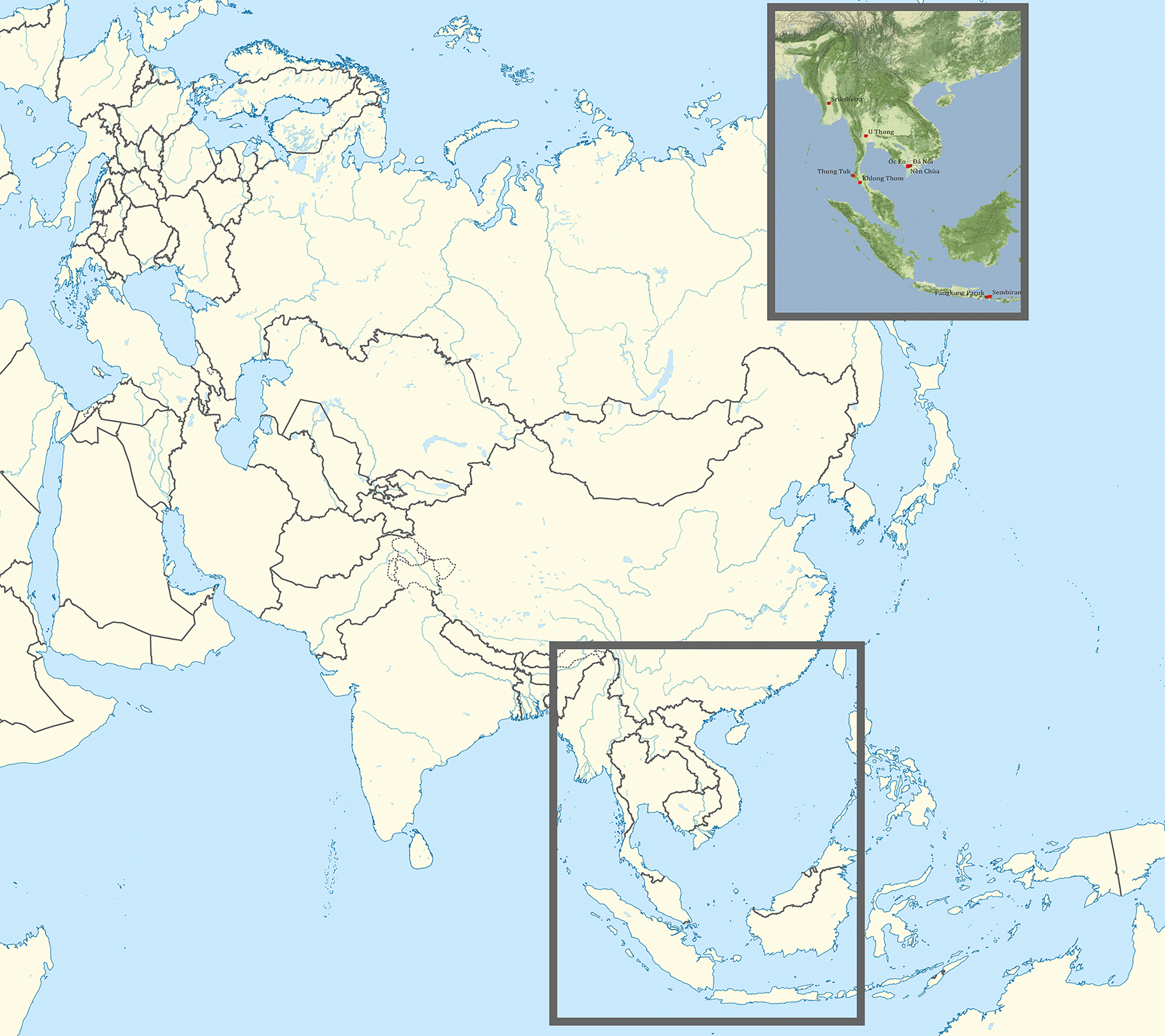
Figure 1. General map of the Indian Ocean with SEA in focus. (Based on © Wikimedia Commons.)
The article begins by introducing the sites, the categories of materials dealt with and the methods used to generate an expanded and critical synthesis on the Mediterranean and related materials found in SEA. These categories, their proportions and differentiated distribution are then contrasted with the Roman materials found in South Asia and China to discuss:
1. Early global connections and exchange networks. What is the contribution of Mediterranean materials to the understanding of economic exchanges, to the communities involved in networks of Asia?
2. The history of consumption and appropriation within the consumers’ cultures in the context of Mediterranean and related materials found in SEA. How to interpret in cultural terms the varying Mediterranean elements present, the concentration of the different categories (imported versus inspired), and qualities within the different communities and through time?
This study not only contributes to building the sequence of cultural exchanges, in particular between South and Southeast Asia, emphasizing privilege links between communities, but also challenges the widespread assumption about Mediterranean influence there. Instead, it shows how these Western elements are only present as they conform to local ideational or cultural realities of specific groups, mostly belonging to a cosmopolitan milieu. In addition, these Western elements that reached Southeast Asia were already conformed to and filtered by South Asian values.
Scopes and limits
The paper focuses on Mediterranean materials discovered in SEA but also includes potentially Asia-produced objects that are integrating elements of Mediterranean style, iconography, visual solutions and/or technique to varying degrees. Despite the fact that such objects were typically made by local Asian communities residing outside the Roman Empire, those are often incorrectly referred to as Roman in the literature.
We include objects discovered in Mainland and Island SEA: Cambodia, Myanmar, Thailand, Vietnam and Indonesia, while finds from South Asia and China are only used for comparison.
Most of the Mediterranean and related objects lack a secure archaeological context, limiting interpretations and their arrival and burial times. Moreover, different regions in SEA have been unevenly investigated.
However, this study compensates for some of these weaknesses as it gathers together published materials and data of well-dated recently excavated sites in SEA, mostly consisting of port-settlements and industrial sites. Many objects discussed below come from those and benefitted from compositional analysis. Those helped reconsider otherwise poorly defined material lacking secure context.
Sites and new data (Fig. 2)
Materials come from 15 different sites located in the following regions: (central) Myanmar, (central) Thailand, Kra Isthmus (Thailand and Myanmar), peninsular Thailand (further south of the Kra Isthmus), Greater Mekong Delta Region (southern Vietnam and Cambodia), Island SEA (Bali). Objects from the Kra Isthmus generally have a better context that we will describe first before discussing more briefly the context of the artefacts from the other regions of SEA included in this study.
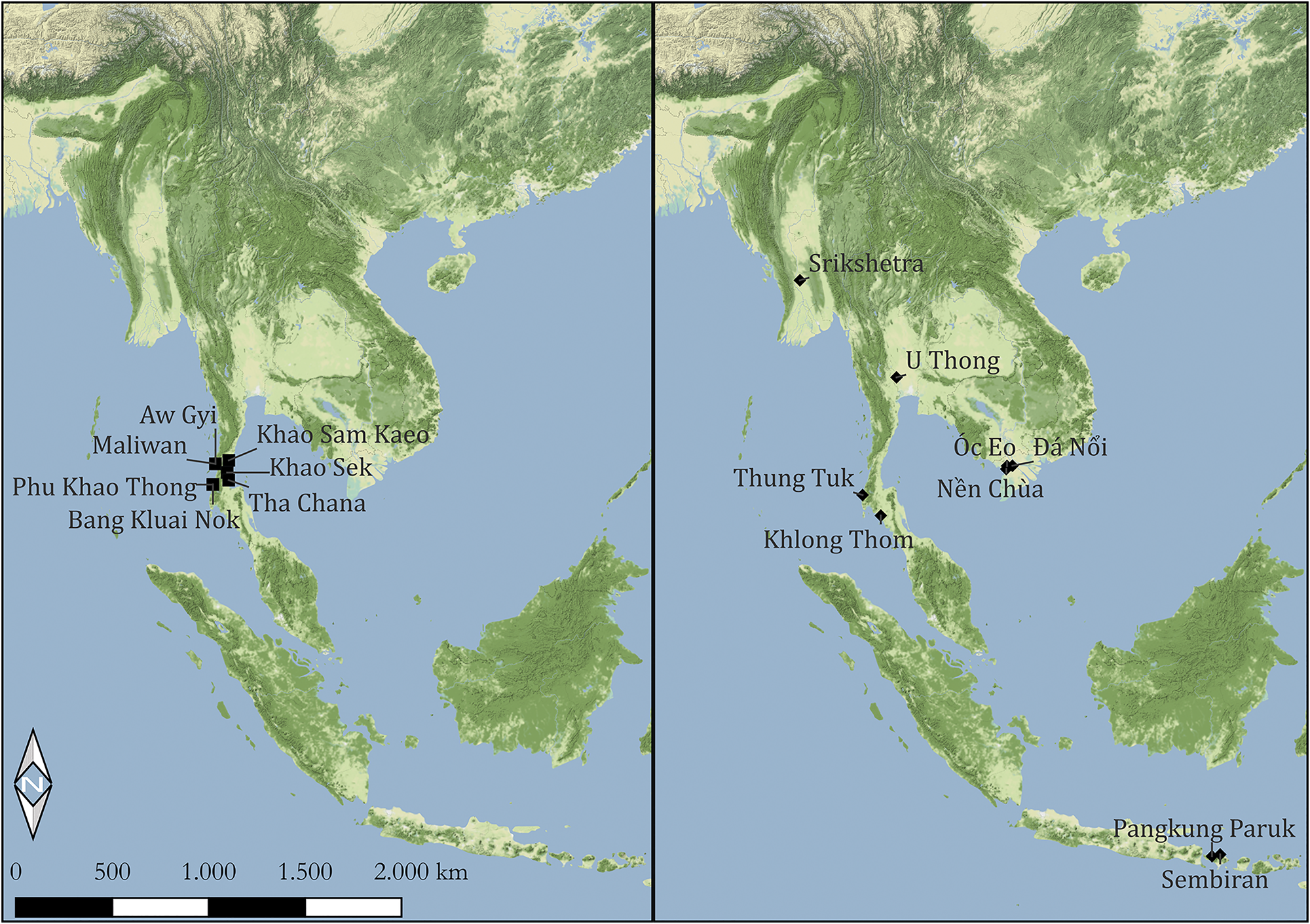
Figure 2. Distribution map of early sites (left) and later sites (right).
Sites from the Kra Isthmus
A large proportion of the original evidence connected to the Mediterranean comes from the Thailand and Myanmar sections of the Kra Isthmus. It is there that the French Archaeological Mission in Peninsular Thailand-Myanmar (FAMPTM) has been working since 2005 and has investigated 36 sites, some intensively, whilst others are known from survey and surface collections.Footnote 1 Seven port-settlements were investigated, each providing important information on craft production and distribution. One hundred and five radiocarbon dates were obtained from various organic materials, mainly charcoal: 77 come from settlements, mostly Khao Sam Kaeo in Thailand and Maliwan in southern Myanmar.
A few contextualised Mediterranean and related materials came from these excavations, some in the form of imports, others in the form of what we refer to as hybridized materials, i.e. objects that combine Western and local stylistic and technological elements.
Based on the results and other tentative dates, the sites in and around the Kra Isthmus are divided into the following groups of periods:
Late prehistoric sites: fourth century bce–first century ce (Khao Sam Kaeo, Maliwan)
Early sites: from the last centuries bce to the turn of the Christian era (Aw Gyi, Bang Kluai Nok-Phu Khao Thong and Tha Chana)
Protohistoric–early historical sites: from the early centuries ce or later (Khlong Thom and Thung Tuk in peninsular Thailand)
Khao Sam Kaeo (KSK), Chumphon province, Maliwan and Aw Gyi (AG), Kawthaung, Tanintharyi have benefitted from these excavations (Bellina Reference Bellina2017; Bellina et al. Reference Bellina, Win and Htwe2018; Dussubieux et al. Reference Dussubieux, Bellina and Oo2020), and yielded a large variety of already analysed objects (e.g, Bellina Reference Bellina2017). Phu Khao Thong (PKT) was also surveyed on several occasions, some material analysed (Bouvet Reference Bouvet and Bellina2017) and archaeobotanical sampling done (Castillo Cobo et al. Reference Castillo, Bellina and Fuller2016).
All of these port-settlements except Bang Kluai Nok (BKN) yielded large amounts of remains of glass and stone ornament industries whose products were distributed locally as well as regionally as far as the Philippines. KSK emerged as the earliest cosmopolitan incipient city-state acting as the ‘inter-regional’ market-place for a confederation that included Khao Sek (Bellina Reference Bellina2018) and other feeding points and relay stations. Maliwan, contemporaneous to KSK, was also an early walled port-city (Bellina Reference Bellina2018; Reference Bellina, Higham and Kim2022; Dussubieux et al. Reference Dussubieux, Bellina and Oo2020). PKT was probably part of a complex including the neighbouring settlement of BKN (Bellina et al. Reference Bellina, Silapanth, Chaisuwan, Revire and Murphy2014; Chaisuwan Reference Chaisuwan, Manguin, Mani and Wade2011).
Thung Tuk (TT) and Khlong Thom (KT), or Khuan Lukpad, i.e. ‘Bead Mound’, are both situated in peninsular Thailand. The latter hosted several craft activities and local coinage probably associated to a trading polity, an early Tamil-Brahmi inscription, and was probably contemporaneous to Óc Eo (OE) in southern Vietnam, near the Mekong Delta (Chaisuwan Reference Chaisuwan, Manguin, Mani and Wade2011; Veraprasert Reference Veraprasert1987).
Other sites in SEA
Protohistoric-early historical sites: from the early centuries ce or later (Srikshetra; OE (and Lung Lớn), Đá Nổi (DN) and Nền Chùa (NC); U Thong (UT); Pangkunk Paruk (PP) and Sembiran).
All sites outside the Isthmus can be considered as later, such as those located in central Myanmar, the Pyu urban settlement and regional centre of Srikshetra (Thein Lwin et al. Reference Thein Lwin, Win Kyaing, Stargardt and Guy2014).
OE (and the Lung Lớn canal) was occupied as early as the late centuries bce but only arose as a powerful regional centre during the Funan period (c. first–sixth centuries ce), interpreted as the early phase of the Khmer polity (Shewan et al. Reference Shewan, Ikehara-Quebral and Stark2020; Stark Reference Stark2006). A few other contemporaneous sites of the OE culture also yielded Mediterranean materials, namely NC, DN, all from the Mekong Delta. The only site from central Thailand included into the database is UT, a major urban trading, political and ritual centre of the Dvāravatī period from the early fourth–sixth to the tenth centuries ce (Khunshong Reference Khunshong and Tan2018). However, the one single coin adaptation from the site might be of post-fifth-century date.
The only sites from Island SEA yielding Mediterranean materials with a certain degree of reliability are PP and Sembiran in Bali, Indonesia. Both sites benefitted from excavations and are dated to the early first centuries ce (Ardika Reference Ardika, Hauser-Schäublin and Ardika2008; Calo et al. Reference Calo, Prasetyo and Bellwood2015).
Materials and caveats
The materials in this study, all inorganic in nature, include raw material (limited to glass) and finished products. The latter consist of coins, beads, intaglios, amphorae, etc. We created an expandable database into which we included data gathered from publications, museum visits, excavation reports and site analyses. However, in several cases the exact number of artefacts remained unknown, thus identical objects from the same site lacking any individual features are referred to as entries, and their quantity is provided whenever it was possible. This is particularly the case with beads. As a result, the database currently consists of 73 entries. They refer to more than 150 individual objects from the above sites supplemented by the identification, description and the most probable area of origin of the objects, as well as their tentative production dates, site dates and bibliographical references. (Table 1: extended version available online).
Table 1. Simplified database (extended version available online).
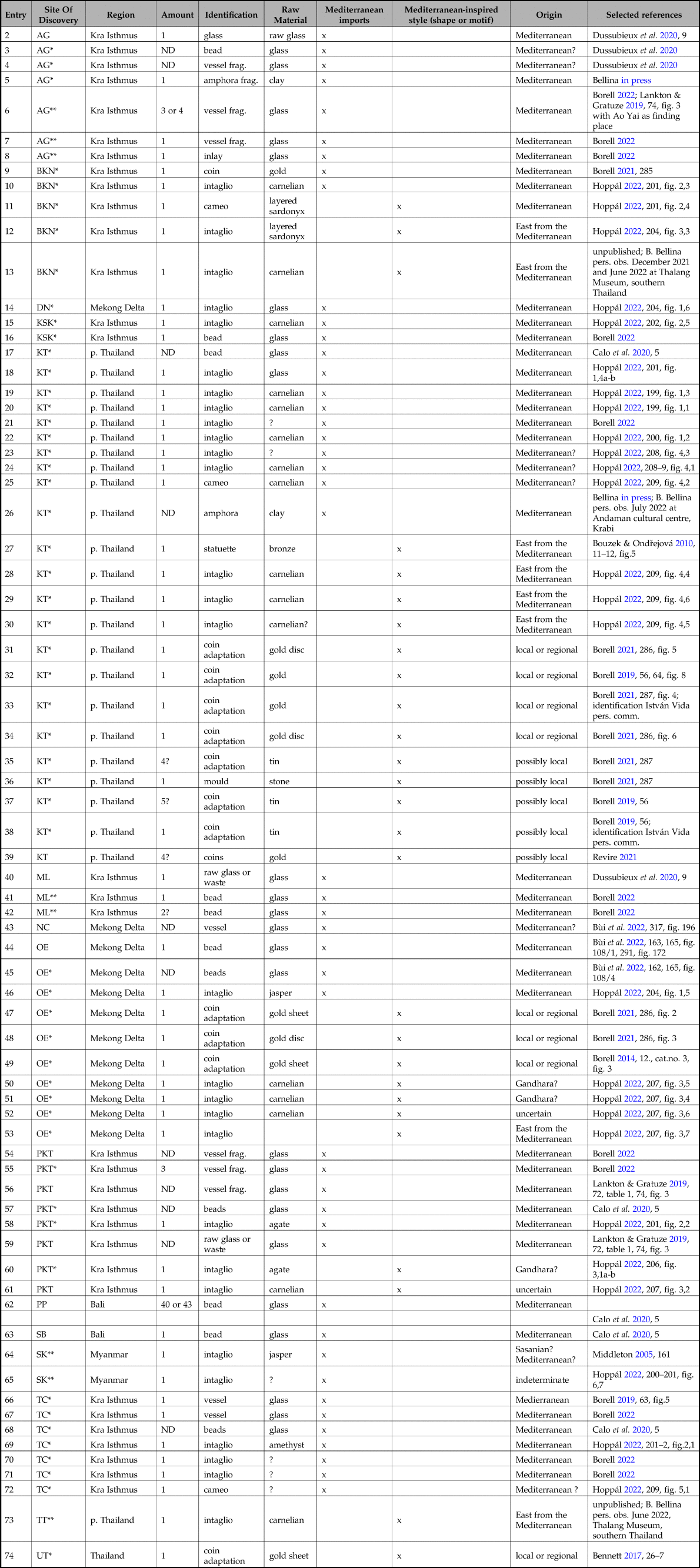
The table excludes objects lacking basic information, which is the case with many glass fragments of Mediterranean composition (e.g. in Lankton & Gratuze Reference Lankton, Gratuze, Pongpanich and Thinapong2019) and objects kept at private collections, or when they suspectedly arrived in post-Roman times as later antiquities, such as the Roman coins from Java and Angkor Borei (Hoppál et al. Reference Hoppál, Vida, Adhityatama and Lu2018), or possibly the Victorinus antoninianus from UT (Borell Reference Borell, Günther, Li, Lin and Sode2021), as well as the beads from different locations in Malaysia (Francis Reference Francis2002, 89–90). Objects whose identification as Roman is debatable are also omitted, such as in the case of the bronze key from OE–Lung Lớn canal (Bùi et al. Reference Bùi, Nguyễn and Nguyễn2022, 167). Private collections retain several other, potentially Mediterranean or related objects; many of those were not included into the database, either because of the lack of accessibility or because their finding site is unknown. This is the case with the gold glass bead depicting Harpocrates claimed to be discovered in the Kawthaung area (Borell Reference Borell2022) or beads acquired near the Thai–Myanmar border (Lankton & Gratuze Reference Lankton, Gratuze, Pongpanich and Thinapong2019).
Because this project primarily focuses on the period between the beginning of Rome's Far Eastern interest until the transformation of cross-cultural communications during the fifth–sixth centuries, post-fifth-century materials were also excluded, such as the Pong Tuk bronze lamp which is unanimously dated to the fifth–sixth century (Borell Reference Borell2008), as well as the probably Western-inspired terracotta lamps from Thailand and Vietnam (for the latter: Bùi Reference Bùi2022, 35–7).
In the case of glass materials, recent elemental analyses provided new provenance and dating information for natron glass or revealed a Middle Eastern provenance in the case of soda plant ash glass samples, which prompted us to reject a number of glass fragments and beads previously associated with Roman trade. For example, two blue natron glass fragments from KSK Hill4 (H4S12 and H4S4) were attributed a fifth-century ce dating based on their composition (Dussubieux & Bellina Reference Dussubieux, Bellina and Bellina2017, 573 table III). Also, a gold glass bead (AKC01057) from Promthin Tai burial 20 has a Levantine composition, dated from the fifth–seventh centuries ce (Carter et al. Reference Carter, Dussubieux, Fenn, Lertcharnrit, Pryce, Dussubieux and Walder2022, 170–71). In the case of plant ash glasses from Angkor Borei Vat Komnou cemetery (AKC02594b; AKC02595; AB005BC; AB015BC; AB023BC; AB025BC; AKC02592) and OE (GEOI9), the K2O and MgO concentrations could point toward an Egyptian origin (Carter et al. Reference Carter, Dussubieux, Stark and Gilg2021, 44–5); however, unpublished isotope analysis revealed that some of the Angkor Borei soda plant ash beads are more likely from Iran or Mesopotamia. For this reason, Angkor Borei and OE beads were not included into the database.
Methods
Data collection and analysis
Some of the materials gathered have been properly analysed (either by laboratory or archaeological methods) and their provenance was identified in publications as having Mediterranean origin or being inspired and produced outside of the Mediterranean. In the case of unpublished and as yet unidentified objects, we relied on our own observations. If more than one identification or dates of the same object circulated in the literature, we chose the one which we considered the most reliable, but included all other references in the bibliography section (see extended database online). We also indicated whenever we had a different suggestion than the published opinion. Several of the included materials lack context, so we indicated whenever the claimed findspot is uncertain (*) or very dubious (**). We created several tables based on different criteria of classification. Sites were grouped by regions instead of being associated with modern countries (for example, Kra Isthmus includes sites in southern Myanmar and Thailand) and tentative dates of their main occupation periods in order to illustrate distribution patterns according to space and time.
The synthetic table integrating the different material types from each site helps to visualize and compare the quantity of various objects in different regions (Figs 2 & 3; Table 2). This also showed certain differences in quantities of material types and distributions which can be partly explained by methodological reasons, illustrating the pitfalls of research. In general, sites in SEA have been unevenly excavated and analysed. Most recent excavations were conducted on early sites whose materials benefitted from more laboratory analysis. Materials were also grouped according to their general appearance and visual (and observable technical) characteristics, and were compared by regions. Mediterranean objects of fine and skilled workmanship with rich decoration and/or detailed modelling, and made of precious raw materials (such as semi-precious stones or pure gold), produced at a limited number of regions within the Imperium, were regarded as of high quality (22 entries). Our second group consists of Mediterranean objects of secondary quality, average appearance and standardized representations, manufactured in a greater quantity (some even mass-produced), at more widespread production places all over the Imperium; also inspired objects, as those feature inferior visual and/or technical characteristics compared to high-quality Mediterranean objects; thus all of those were grouped into this second category (altogether 51 entries).
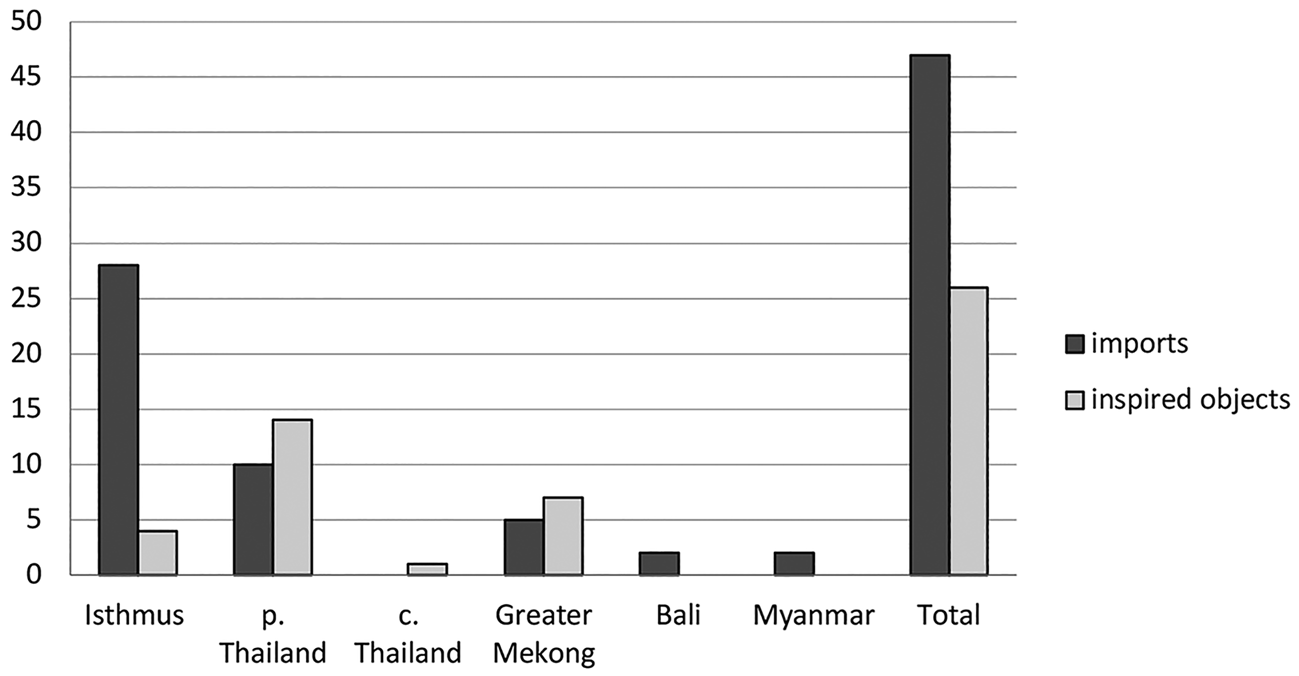
Figure 3. Proportion of Mediterranean imports and inspired objects.
Table 2. Synthetic distribution.
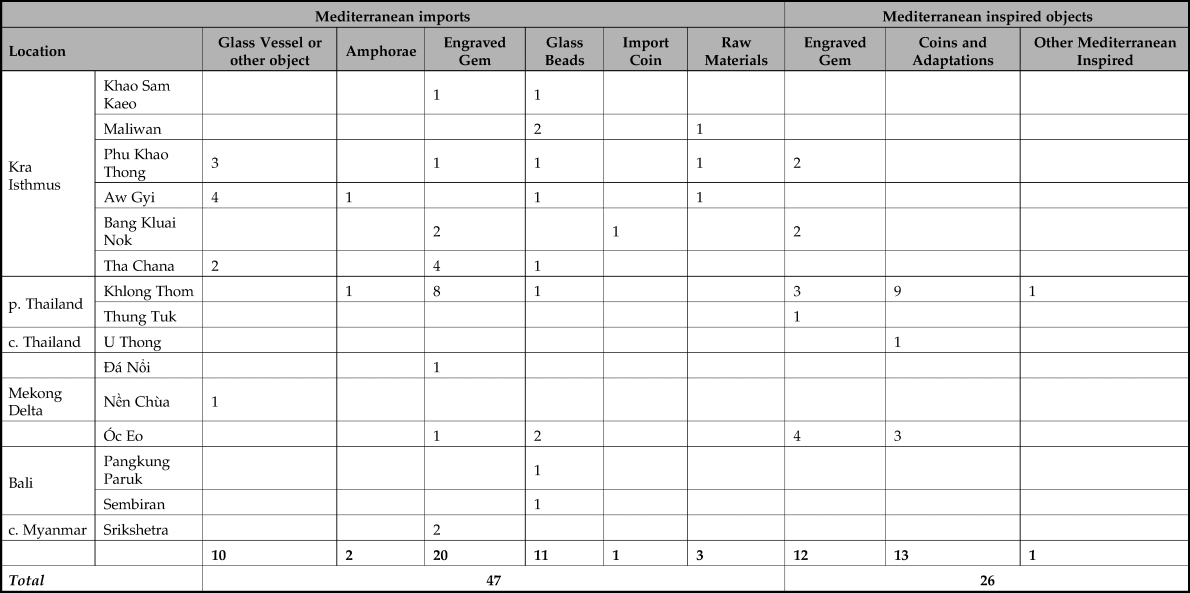
Analysis of the material
Each material type has its own peculiarities both in terms of identification and interpretation implying slightly different analytical methods.
Glass
In the case of SEA discovered glass materials, only a limited number could be identified as Roman based on typological and stylistic analyses. Those are mostly decorated glass vessels, and a few decorated glass beads. In all other cases, particularly with small fragments of undecorated glass vessels, simple beads and waste, only elemental composition obtained with chemical analyses could help determine the possible place of origin.
Recent research distinguishes several sub-groups for the mineral soda-lime glass manufactured from natron during the first millennium ce. Looking at the concentrations of different oxides related to the source of silica: SiO2, Al2O3 and TiO2, it is possible to separate glasses made in Egypt from glasses made in the Levantine area at different periods (Freestone Reference Freestone, Klimscha, Karlsen, Hansen and Renn2020; Schibille Reference Schibille2021).
However, sometimes only a broader range of dating can be inferred, because the composition corresponds to such a wide time window, for example in the case of Roman Mn glass that is dated from the first to the fourth centuries ce.
Coins
Identification of genuine Roman coins is generally based on their weights, dimensions and representations of their obverses and reverses. However, by comparing their distribution and circulation patterns and mints with similar issues, and the identification of other coins they were discovered with, certain differences from the typical Roman coinage might be revealed. Such anomalies would suggest the studied coin being post-Roman or even a modern arrival. This is the very case with several SEA-discovered Roman coin finds (Hoppál et al. Reference Hoppál, Vida, Adhityatama and Lu2018).
In the case of pendants and coins evoking Roman coin designs discovered in SEA (referred to as coin adaptations), the Mediterranean (Roman) elements are apparent: those all fall into the category of Mediterranean-inspired. Their raw materials (tin in particular), weights, technical characteristics (casted or embossed in repoussé technique), anomalies regarding their iconography or arrangements of motifs, or bearing illegible or corrupted legends, are all revealing their difference from Roman originals.
Engraved gems
Identifying the origin of engraved gems is more complicated. Engraved gems in the tradition of Roman gem-cutting, that is to say those representing Classical motifs, featuring Roman style and often being engraved in a wheel-cut technique or, in the case of glass, formed in a mould, are considered Mediterranean. Engraved gems featuring motifs derived from Classical iconographic schemes but differing from Mediterranean originals in their modelling, imagery, style, or overall appearance are considered Mediterranean-inspired. In the case of properly examined engraved gems, provenance had been identified through stylistic analysis, and their place of production as well as their tentative dates had been established (Borell Reference Borell2017a, etc.). When not examined, such objects were considered dubious and signified with question marks in the database.
Results
Materials: types and proportions
Glass, in the form of raw material, vessel fragments or beads, represents the most frequently reported Mediterranean import materials (10 + 11+ 3). It is then followed by engraved gems (20 imports, 12 Asia-made) and coins, mostly local adaptations (13 entries) and with only one reported import. Such a corpus of glass materials may partly be due to the fact that they are easily identifiable and preserve well (Table 1).
Among the 10 entries of glass vessel fragments, seven entries are dated to the first century ce based on stylistic comparisons, among which six entries are decorated glass vessel fragments, and entry 8 is a furniture inlay. Others are all undecorated fragments whose range of dating is much broader, from the first century ce to the fourth. Among the 11 entries of glass beads referring to more than 50 individual beads, only three entries of face beads are datable relatively precisely, to the first century ce. All others have a wider range of dating. Among those, five entries are gold glass beads, two entries are mosaic beads (Fig. 4).
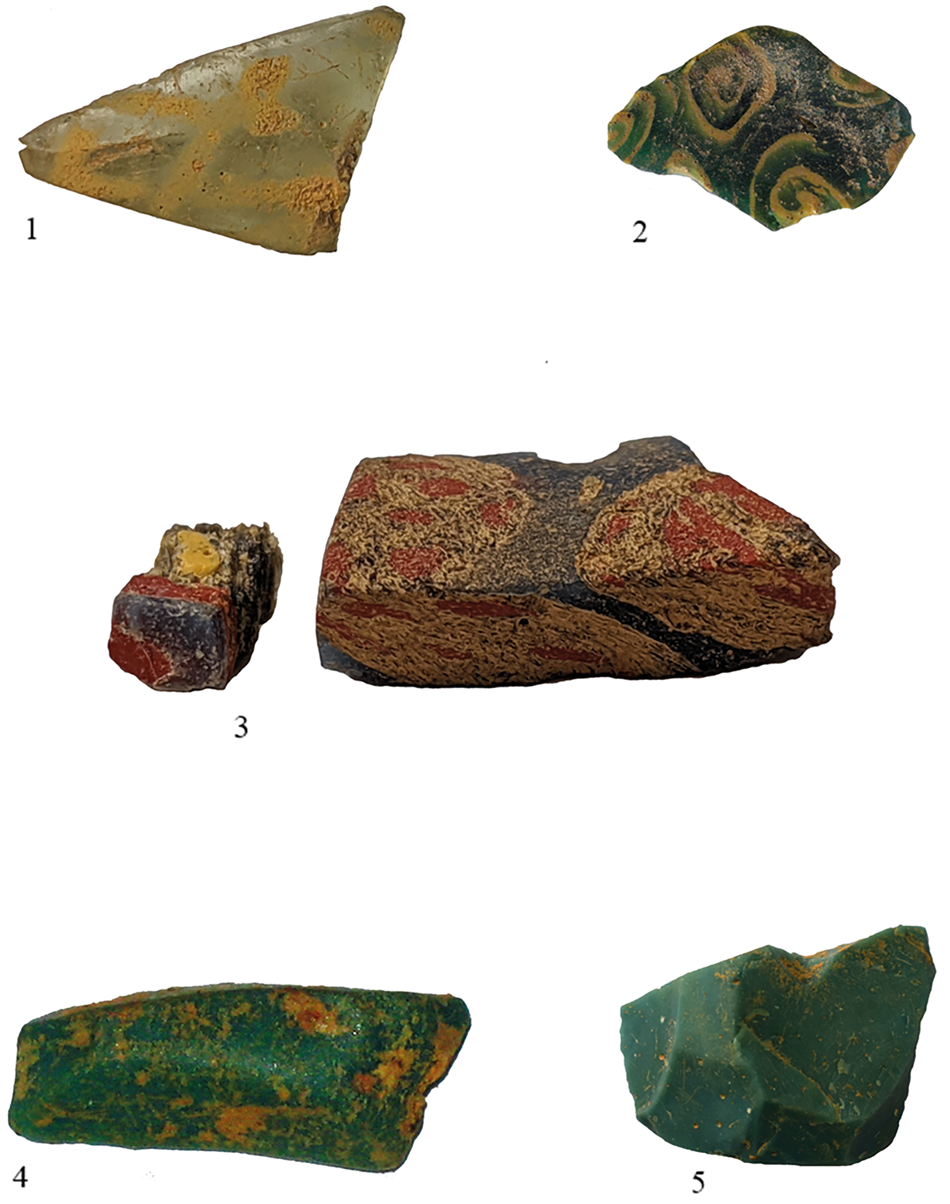
Figure 4. Mediterranean glass from early sites (1–3: PKT; 4: AG; 5: Maliwan). (After Borell et al. Reference Borell, Bellina, Chaisuwan, Revire and Murphy2014; © L. Dussubieux.)
Most of the 20 Roman imported engraved gems are intaglios. There are only three cameos. All the 12 Mediterranean-inspired engraved gems are intaglios. In some cases, their raw materials remained unidentified. Among the known pieces (both imported and inspired), carnelian appears most frequently, then agate, amethyst, jasper and layered sardonyx (Fig. 5).
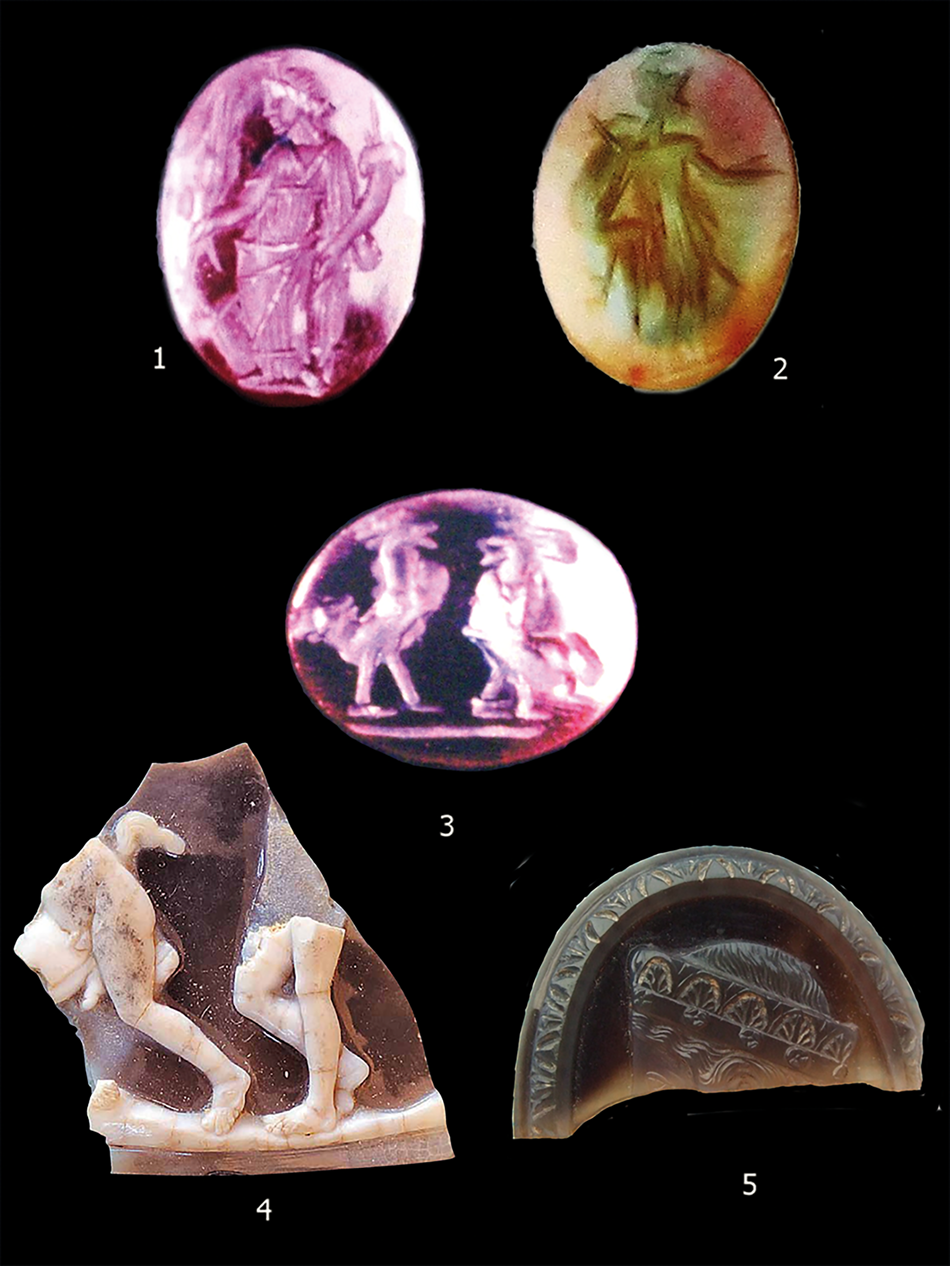
Figure 5. Mediterranean engraved gems (1, 3: KT; 2: KSK; 4: BKN; 5: TC). (After Bouzek & Ondřejová Reference Bouzek and Ondřejová2010; Borell et al. Reference Borell, Bellina, Chaisuwan, Revire and Murphy2014; © B. Bellina.)
Human representations are very frequent, out of which (Roman) religious beliefs and sacro-idyllic scenes appear to be the most common subjects (16 out of 20). Bust portraits and combinations of human faces are present in a remarkable number (10 out of 20), and animals (particularly horses and cocks, 5 out of 20) (Hoppál Reference Hoppál2022).
Among the 20 Roman imported engraved gems, 12 entries are dated to the first century bce–first century ce; those are typically of high-quality craftsmanship, such as entry 69 or entry 11 (Fig. 5.4). Three intaglios are dated to the second century ce or mid second–third century ce; others have not been dated yet or have a wide range of dating. All of those have standardized motifs and represent examples of Roman mass production, such as entry 15 (Figure 5.2).
In a few cases the place of manufacture for the Mediterranean-inspired intaglios could be identified through parallels of iconographic scheme (see above), such as entry 60, which might have been produced in the northern or northwestern region of South Asia, possibly in Gandhara. However, in most cases their place of production remained unknown, or uncertain because of the lack of comparable materials or because of their controversial characteristics.
Providing tentative dates for the 12 inspired engraved gems is much more problematic. Two entries might be dated to the first century ce (entry 12, Fig. 6.1 and entry 60), while others were suggested to be produced after the third century ce (entry 50 and entry 51, Figs 6.2 & 6.3).
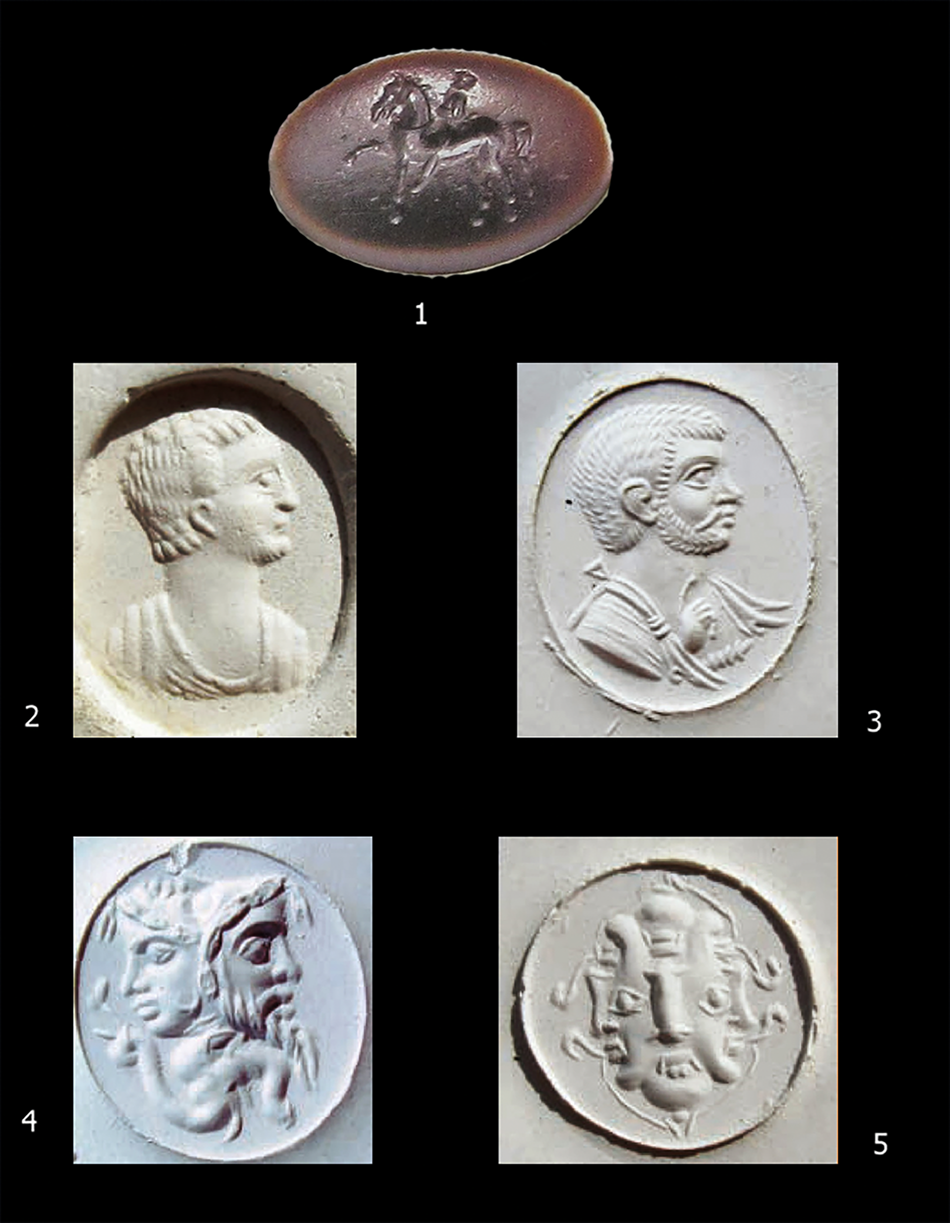
Figure 6. Inspired engraved gems (1: BKN; 2–5: OE). (After Borell et al. Reference Borell, Bellina, Chaisuwan, Revire and Murphy2014; Malleret Reference Malleret1959–1963.)
Despite the fact that Roman coins are easily identifiable and have long attracted the collector's interest, the only genuine Roman coin which most likely arrived to SEA prior the fifth century ce is a very worn aureus issued by Domitian in 86 (RIC II/12 Domitian 426) from BKN. The coin features a double piercing just above the emperor's head—a phenomenon relatively frequent in South Asia—and a small fragment of attached gold, possibly reminiscent of ornament usage, perhaps by tying to a thread, similar to some of the coin adaptations from KT with post-second-century dates. Its different suspensions seem to suggest two different stages of its use as a jewellery: one in South Asia and another in SEA (Borell Reference Borell, Pongpanich and Thinapong2019). However, its length of use or its arrival time to SEA can hardly be estimated.
The lack of genuine Roman coins is compensated by the relatively large number of coin adaptations (at least 23 individual pieces are known to date). Depending on their raw materials, technical features and the crudeness of their representations, several groups can be formed: tin pendants with crude representations derived from coins of Tiberius PONTIF MAXIM type (four pieces and a stone mould); pendants made of gold sheet and discs with relatively faithful representations partly or entirely derived from coins of the Antonine Dynasty (6); gold pendants with crude representations faintly evoking Roman coin designs (2); tin pendants with crude representations faintly evoking Roman coin designs (6); pale gold coins used as medium of transaction decorated with a profile head recalling Roman coin designs (4) (Fig. 7).
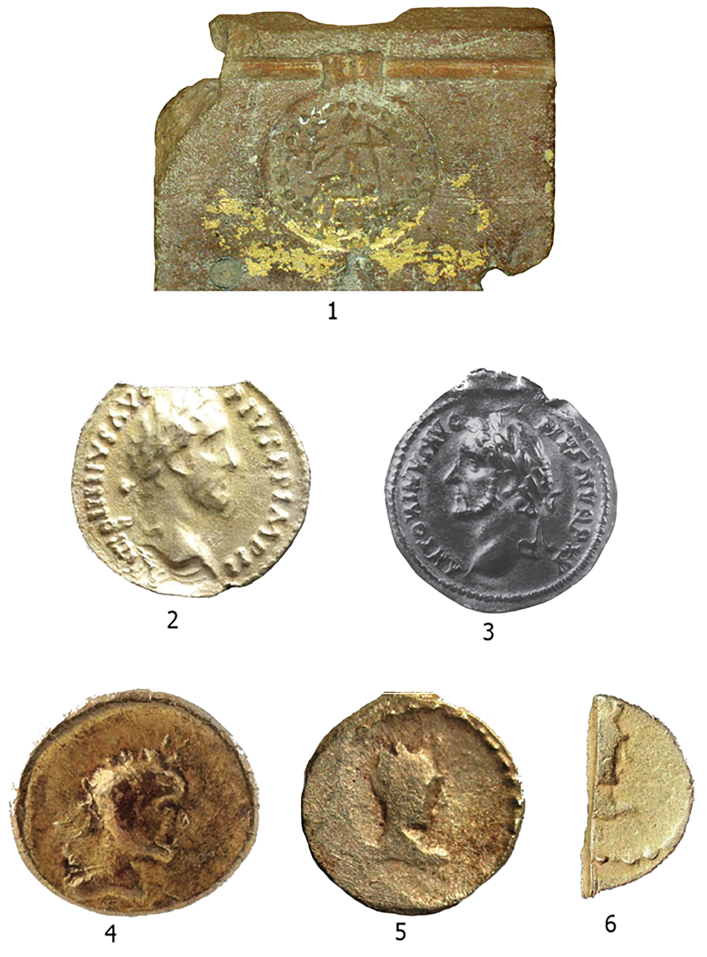
Figure 7. Stone mould and coin adaptations (1, 2, 4–6: KT; 3: OE). (After Borell et al. Reference Borell, Bellina, Chaisuwan, Revire and Murphy2014; Borell Reference Borell2017c; Malleret 1959–1963.)
We report two amphoras; however, probably not only a few amphoras reached SEA through South Asia, but also, they are only rarely identified. The AG base was a surface find Bellina saw at a villager's there that R. Tomber identified as a Dressel 2-4 dating to the late first century bce and the early centuries ce (Bellina Reference Bellina and Selvakumarin press). Bellina spotted a handle in a display dedicated to KT beads at the Andaman Cultural Center in Krabi, which was not identified as a fragment of amphora. Based on photographs, Dr Antigone Marangou (Rennes 2 University) suggested that it could be a Dressel 2-4 type amphora from Italy dated to the first or second century ce.
Among Roman-inspired objects, there is one single statuette depicting a young male from KT (entry 27). Bouzek and Ondřejová (Reference Bouzek and Ondřejová2010, 11–12, fig. 5) suggested that it was made outside of the Roman Empire.
When all materials are combined, imports dominate. They represent 47 entries against the 26 inspired objects; the latter come from more recent sites.
Distributions (Tables 1 & 2)
Some general observations regarding the distributions can be made.
Distribution of imports versus inspired (Figs 3 & 8)
The majority of the materials, whether imported or inspired, come from the Kra Isthmus (32 out of 73) and Peninsular Thailand (24), then the Mekong region (12), Bali (2), Myanmar (2) and Central Thailand (1).
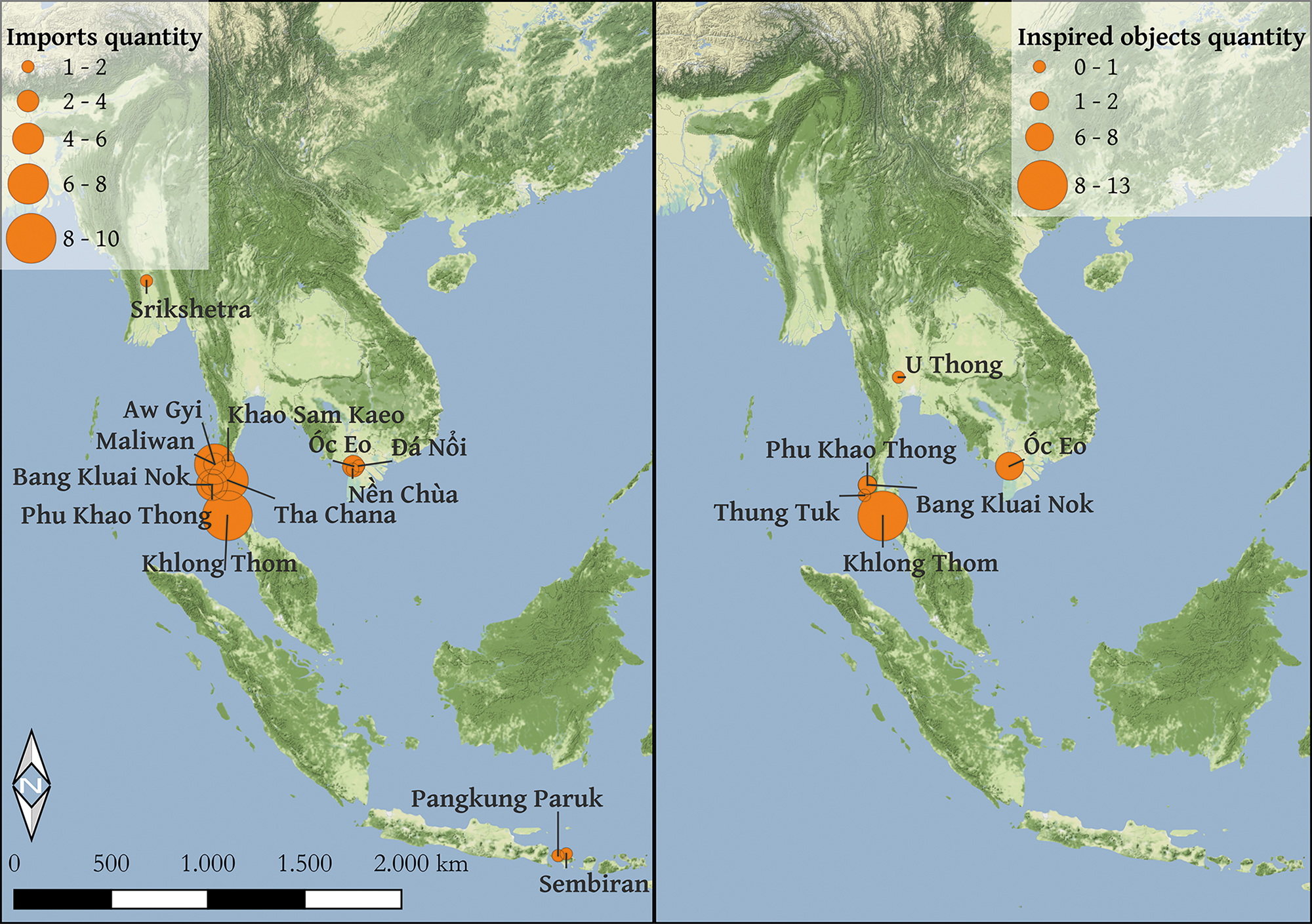
Figure 8. Distribution map of Mediterranean imports and inspired objects.
All types of Mediterranean imports or inspired materials are found in the vast majority in the port sites of the Kra Isthmus, peninsular Thailand and the Mekong Delta. A few other non-port sites have delivered them and these are later sites. We are not aware of Mediterranean-related materials found in the ports’ hinterland.
Most of the Mediterranean imports came from the Kra Isthmus (28 entries), while KT in peninsular Thailand yielded 10 Mediterranean-import objects. From the Mekong Delta, five Mediterranean-import objects were discovered. Central Myanmar only yielded two import objects. Although the two sites from Bali have two entries of Roman imports, at PP altogether 40 or 43 pieces of gold foil beads (the exact number varies depending on the publication: see Calo et al. Reference Calo, Bellwood, Lankton, Reinecke, Bawono and Prasetyo2020, 5; Westerlaken Reference Westerlaken2011, 10) were recovered from the same grave; this means the greatest number of Mediterranean import objects from one single site of SEA to date.
Most of the Mediterranean-inspired objects were discovered in peninsular Thailand (altogether 14 entries out of 26) from KT, then seven came from the Mekong Delta, four from the Kra Isthmus and one from Central Thailand. Except for the Kra Isthmus, all were found on protohistoric–early historical sites dating from the first centuries ce. The more recent the sites, the more adaptations they provide.
Distribution of the different materials
Glass (Table 2 & Fig. 9)
Most glass vessels and objects were found in the Kra Isthmus on early sites (9 out of 10) and then in the Mekong Delta (1). The largest corpus comes from AG (4). Mediterranean glass as a raw material has only been identified at AG, Maliwan and PKT, sites on the Kra Isthmus, which are production sites for glass ornaments. There is no doubt that these figures reflect unevenly distributed archaeological research in SEA, but not only. So far, only the Thai-Malay Peninsula and the Great Mekong region have provided evidence of large-scale trade-related industries.
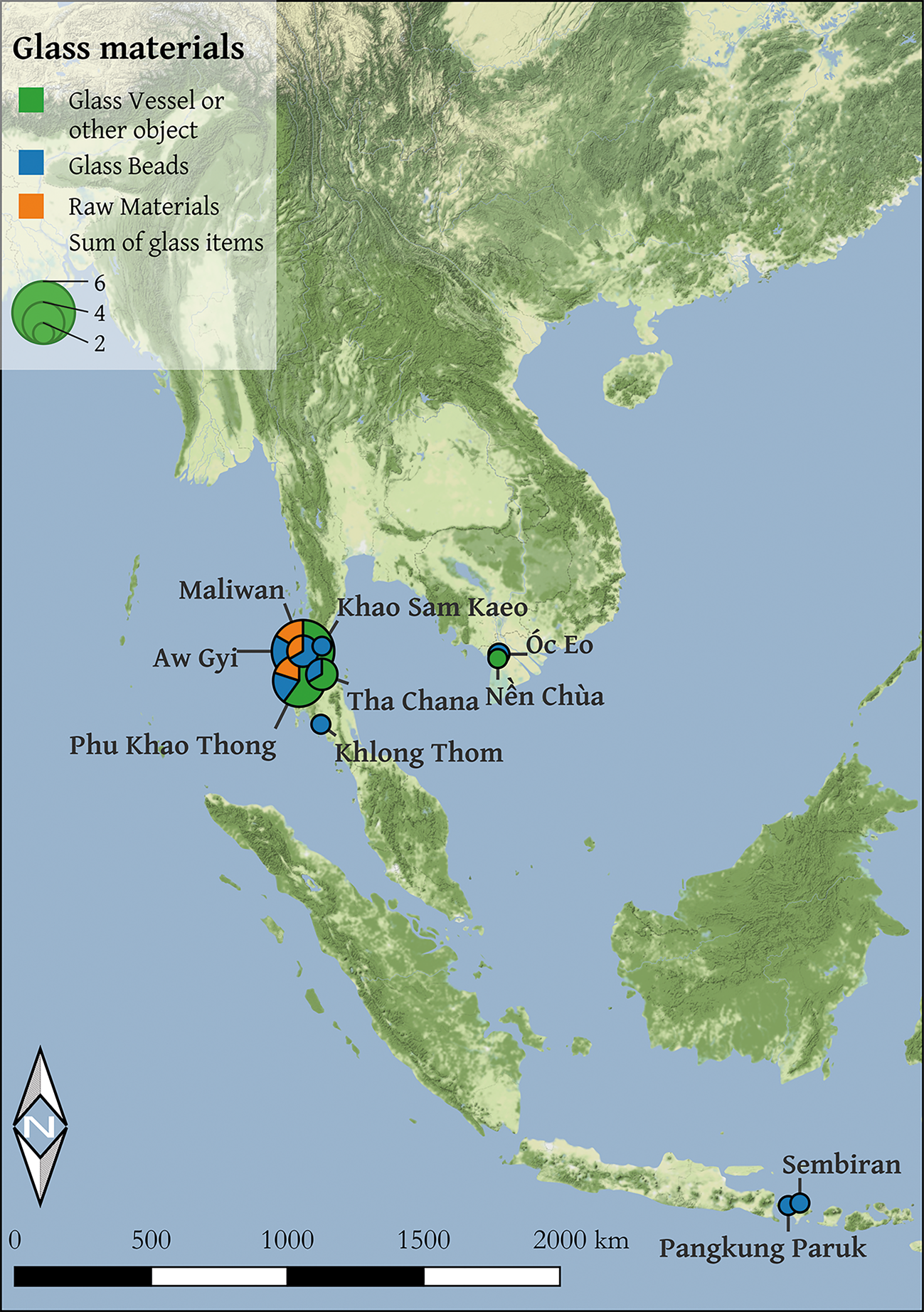
Figure 9. Distribution map of Mediterranean glass materials.
Engraved gems (Table 2 & Fig. 10)
Most imported engraved gems were found on early sites of the Isthmus (8 out of 20), peninsular Thailand (KT 8) and the Great Mekong Region (2).
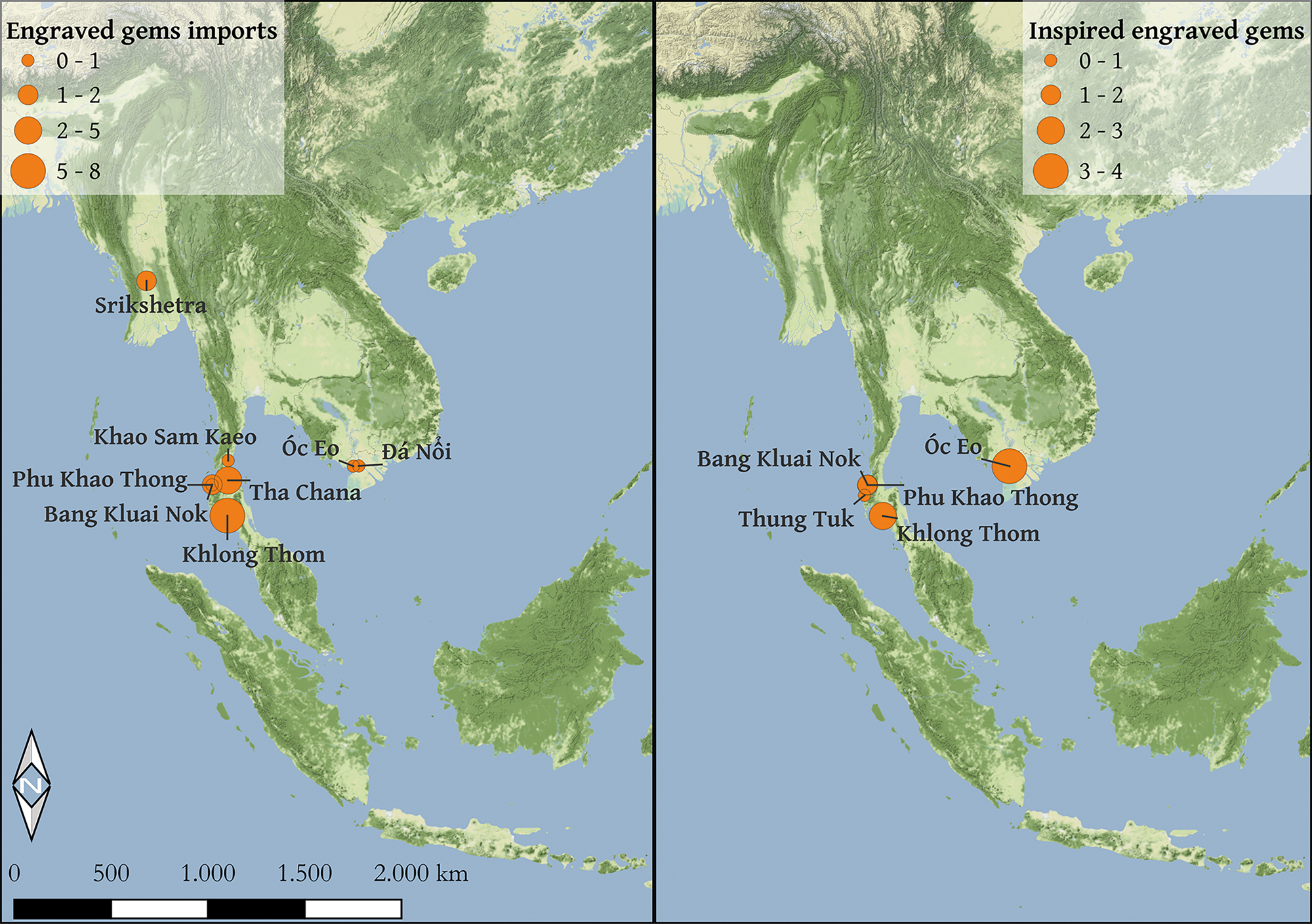
Figure 10. Distribution map of Mediterranean and inspired engraved gems.
Inspired objects
Most of the Mediterranean-inspired objects came from protohistoric–early historical sites (22 versus 4). Among those, coin adaptations, of which at least 19 individual objects (9 entries) came from KT, three from OE and one from UT. As for the 12 inspired engraved gems, four came from (early) sites of the Kra Isthmus and eight from protohistoric–early historical sites: four from Peninsular Thailand (KT and TT), four from the Mekong Delta (OE).
Distribution of the datable materials confirms the above observations. The earliest datable objects of Mediterranean origin in SEA are decorated glass vessels and engraved gems produced between the late first century bce and the early first century ce, and those were exclusively found in the Kra Isthmus. This region yielded most of the other datable early objects (20 out of the 25 objects with pre-second-century ce tentative production dates), while most of the datable later objects (with post-second-century ce tentative production dates) came from peninsular Thailand (12 entries) and the Mekong Delta (six entries). However, there are altogether 27 entries with unknown dates or with a wide range of dating covering several centuries over the 46 datable entries. Moreover, it also unveils the problems between the grouping of sites and of objects based on their dates, as one of the latest objects (entry 15, possibly dated to the mid-second century–early-third century ce) came from KSK, which is one of the late prehistoric sites, situated on the Kra Isthmus (cf. Borell Reference Borell and Bellina2017b, 611–12). KT also stands out from this pattern, as it yielded both pre-and post-second-century ce finds, despite the fact that the site is considered as belonging to the later period.
Distribution of objects by quality (Fig. 11)
Regarding the quality of Mediterranean imports and related objects, there are 22 entries of high-quality objects and 51 entries of mass-produced Mediterranean imports and inspired objects. Looking into their distributions, it is again the Kra Isthmus which yielded most of the high-quality materials (17 versus the 5 from peninsular Thailand), all with pre-second-century tentative production dates.
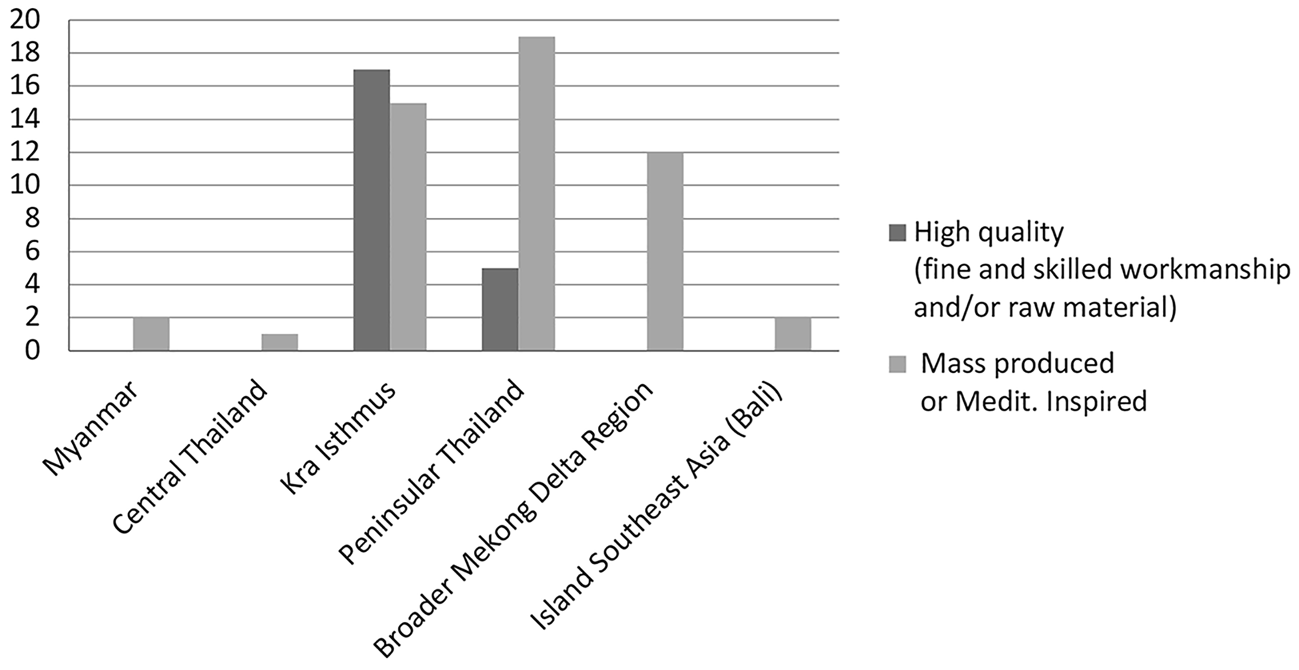
Figure 11. Proportion of high-quality Mediterranean imports and lower quality objects.
To sum up, early sites of the Kra Isthmus consist of ports, some clearly cosmopolitan, and provide Mediterranean imports mostly, glass being the most frequent and Maliwan the first site providing Mediterranean raw glass. They also yield the largest corpus of intaglios, which are imported, of very fine quality and depict human representations and Roman religious beliefs and sacro-idyllic scenes. They date from the first century bce–first century ce. To this period belong the two fragments of amphorae.
Protohistoric-early historical sites in peninsular Thailand and the Great Mekong Region mostly provide inspired objects: coin adaptations and intaglios, and Roman imports of lower quality.
Discussion
Comparison with South Asia
The categories of Roman materials found in South Asia and SEA are broadly the same, although there is much more diversity in South Asia. There, most represented materials are coins and amphorae, whilst those are very underrepresented in SEA. It is not unthinkable that coins were melted there, especially if made in gold, as this happens with jewellery. In South Asia, as opposed to SEA, most Roman coins were found outside ports and come from hoards situated along trading routes. In southern South Asia, 6800 coins from 75 hoards are reported and most of them date to the Julio-Claudian period (first century bce–second century ce) (Rajan Reference Rajan2019). This situation contrasts with SEA that mostly yielded coin adaptations coming from more recent sites. Those—particularly the Tiberius PONTIF MAXIM type—relate to southern South Asia adaptations of Roman coins used as pendants (see below).
Amphorae are, in comparison, more frequent in ports of southern South Asia. The two fragments we report here from southern Myanmar and peninsular Thailand are very likely Dressel 2-4. In both the Mediterranean and South Asia, dates depend on what production site they come from—but in South Asia the Koan and the Campanian are most frequently found between the late first century bce and the first century ce; other production centres can be slightly later (Roberta Tomber, pers. corr. with B. Bellina 3 June 2020).
In SEA, Roman glass is the most frequent Roman material, while there is no recent thorough review of Roman glass in South Asia. Older data indicate that this type of material remains rather rare in South Asia whether it is in the forms of vessels or beads. Recently the excavations at Pattanam, state of Kerala in South Asia, yielded glass fragments and beads undoubtedly of Roman origin. It includes ribbed bowls (similar to what was found at Arikamedu and SEA) and mosaic containers, although no study of these artefacts has been published yet beyond a few photos (Cherian Reference Cherian2014). Glass foil beads were also found at this site (Abraham Reference Abraham, Kanungo and Dussubieux2022) although no chemical analysis was undertaken on those to confirm their origin.
South of the River Narmada, only three intaglios have been reported to date (de Saxcé Reference de Saxcé, Billé, Mehendale and Lankton2022, 134, table 5.1), while in SEA, besides glass, engraved gems are the most frequent Roman and related material; most are imported. However, some similarity regarding the themes depicted on intaglios can be detected. This is the case with the carnelian intaglio representing Fortuna from Pattanam, coming from a layer dated to the early centuries ce (Cherian Reference Cherian2014, 82–3), to which the Fortuna intaglio from KT (entry 19, Fig. 5.1) and a yet-to-be-examined piece from southern Myanmar (Hoppál Reference Hoppál2022, 199, table VI/fig 6; Pongpanich Reference Pongpanich, Pongpanich and Thinapong2019, 266) are strikingly similar. In all three cases, Fortuna is represented with similar attributes (cornucopia in particular), although they differ in quality of workmanship.
Our knowledge of Roman-inspired intaglios in SEA is limited. The few examined pieces relate to Gandhara. However, most likely southern South Asia also produced Roman-inspired intaglios. A carnelian intaglio depicting Augustus and another piece with Cupid and a bird reported to be from Arikamedu are two of the possible examples (Wheeler et al. Reference Wheeler, Ghosh and Deva1946, 21–2, plate XXXIIIB, 11). Because the latter intaglio is untrimmed, Wheeler believed they were made locally by Mediterranean craftsmen, but Cobb (Reference Cobb2018, 161) suggests that they are rather locally made inspirations. More examples might be revealed by detailed examination of intaglios excavated in Pattanam (see e.g. Cherian Reference Cherian2014).
Some material types have not been reported so far in SEA, such as terra sigillata, bronzes (particularly fibulae), terracotta lamps, or coins (the only one from SEA was worn as a pendant). In South Asia, there are a number of unique or non-trade-connected objects, such as the alabaster Eros from Junnar (Cobb & Mitchell Reference Cobb and Mitchell2019), or Roman board game counters from Pattanam (Cherian Reference Cherian2014, 71). Types of inspired objects (typically adaptations) in South Asia are also more diverse; besides coins, terracotta figurines, jewels, etc. were also adapted (e.g. Brancaccio Reference Brancaccio2014); these have not yet been detected in SEA.
To summarize, while South Asia, and especially southern South Asia, share Roman and Roman-adapted materials with SEA, the quantity and diversity is always greater in South Asia and materials are found in more varied contexts. This is not surprising if one considers South Asia's more direct links with Mediterranean networks. Differences in choices and appropriations of objects can be seen between regions within South Asia (de Saxcé Reference de Saxcé, Billé, Mehendale and Lankton2022), and also between South Asia and SEA, as illustrated by the high number of engraved gems from SEA.
Comparison with China
The diversity of SEA-discovered Mediterranean import materials is in striking contrast to China (without Xinjiang), where exclusively glass materials—vessels and beads of Mediterranean origin—solely from graves can be found (Hoppál Reference Hoppál2020).
The number of Roman glass vessels is similar (at least 16 pieces) to that in SEA. Most of the Roman glass vessels came from the region of Nanjing and Liaoning-Hebei provinces. Among those, only three have first-century ce dates,Footnote 2 while there are a dozen from fourth- and fifth–sixth-century ce burials (Hoppál Reference Hoppál2020). The three early Roman glass vessels from China might indicate some degree of links with the Kra Isthmus, where similar types of early glass vessels were also found.
Receiving the foreign
The above distributions revealed a significant accumulation (particularly in southern Thailand with Myanmar and the Mekong Delta) of objects with figural representations (especially human and animal) in Mediterranean style, principally engraved gems both Mediterranean and Mediterranean-inspired, as well as coin adaptations (altogether 48 entries versus 25 entries of all the other materials). These objects might have had a meaning for the consumer, as was the case with glass vessels of Mediterranean origin discovered in China (without Xinjiang). In the eastern coastal areas these glass vessels prior to the fifth–sixth centuries ce can be found exclusively in royal tombs (Hoppál Reference Hoppál2016). They seem to be attributed with extra values, not simply because of their distant places of production and exoticism, but rather because they were seen as a simulation of jade (An Reference An, Watt and Harper2004, 58), supplemented by the lack of knowledge regarding the details of their manufacturing techniques. This reception of non-local glass vessels greatly differs from what we can see in the culturally heterogeneous Xinjiang area, where more variety of Mediterranean materials can be found from more diverse archaeological contexts (Hoppál Reference Hoppál2020).
In the case of SEA, a few observations regarding the accumulation of engraved gems and coin adaptations can also be formulated.
Engraved gems
Out of the 12 inspired engraved gems, in at least three cases, and also possibly in the case of the bronze statuette (entry 27), a northwestern South Asian, namely Gandharan, production place or source of inspiration can be hypostasized. A recently re-evaluated example is entry 60 from PKT which is presumably dated to the first century ce (Borell Reference Borell2017a). Other evidence of links between sites of the Kra Isthmus and the Gandhara region is also known; one such example is the gold foil S-motif found at KSK showing connection to the first-century ce gold bracelet from Sirkap, Taxila (Pryce et al. Reference Pryce, Bellina and Bennett2006, 310). However, the other potentially Gandhara-connected inspired objects have much later tentative production dates, particularly entries 50 and 51 from OE. Based on their stylistic attributes, they might have been produced after the third century ce (Borell Reference Borell2016b, 110–11). Possibly entry 27 from KT is also a later product, as it might have been manufactured between the second and third centuries ce—although its connection to Gandharan art is more uncertain (Bouzek & Ondřejová Reference Bouzek and Ondřejová2010, 11–12). It is difficult to form any conclusion based on these few and dubious items, but it seems likely that at least some of the SEA sites might have had some kind of links to the Gandhara region after the first century ce.
Coin adaptations
Southern South Asia served as another source of inspiration—besides several other types of materials (Bellina Reference Bellina, Higham and Kim2022)—for certain types of coin adaptations. Pendants evoking the design of Tiberius PONTIF MAXIM type from KT seem to show direct connection to Andhra Pradesh, but as the stone mould suggests, they were presumably manufactured locally, maybe by South Asian craftsmen (Borell Reference Borell2014, 22–3). The gold pendants of post-second-century ce dates (4 from KT and 2 from OE), however, might be local developments (Borell Reference Borell2014, 27–9). Thus, a ‘double process’ might be hypostatised: first, South Asians localized the Mediterranean models, i.e. wearing coin adaptations as pendants; then these South Asian-adapted models started to be produced locally at KT after the first century ce, possibly even by South Asian artisans. Afterwards, a regional version borrowed both from the South Asian-adapted models and from the Mediterranean originals themselves might be hypothesised. The crude coin pendants from KT, UT and OE seem to be results of later simplification and possibly mass production. The fifth–sixth-century gold coins from KT depict a profile head of the local ruler recalling Roman coins on the obverse and Brāhmī inscriptions provide the Indianized name, Viṣṇuvarman, on the reverse (Borell Reference Borell2017c; Revire Reference Revire2021) (Fig. 7.4–7.6).
Being Mediterranean and coming from a distant land alone could hardly be an explanation for such a concentration of engraved gems and coin adaptations. Figural representations, particularly profile heads and certain animals, seem to be a central feature. Amuletic character of good fortune, prosperity and longevity attached to these objects might be one of the reasonable possibilities—as has already been suggested in the case of the pendants evoking Roman coin designs discovered both in SEA and South Asia (Borell Reference Borell2014, 29–30). Appreciation of these objects for their symbolism within the local cultural context might also be probable. Incorporation and interpretation of specific images into the local symbolism would also explain the repetition of certain western-style motifs in different style and quality (Hoppál Reference Hoppál2022).
In the case of the KT-discovered pale gold coins, the Roman profile head might have been recontextualized through the adopted Indic political symbols. Accepting the theory that the local KT ruler who issued these coins as Śrī Viṣuvama (i.e. Viṣṇuvarman [‘Armour of Viṣṇu’ or ‘He who has Viṣṇu as his protection’] might have seen himself as a representative of the god on earth (Revire Reference Revire2021, 114) would also demonstrate the incorporation of these Roman elements into the local religious symbolism.
Other materials of Mediterranean origin (such as glass vessels), mostly found at port settlements and rarely in the hinterland, suggest that they were more connected to the South Asian local exchange activities as part of the trading network culture, and were possibly less meaningful, hence less likely to be integrated outside the trading communities. Like Indian Fine Ware, they might have been associated with members of the maritime merchant elite (Bouvet Reference Bouvet and Bellina2017).
To sum up, as links between the Roman world and SEA were predominantly indirect, Roman objects and elements were introduced through a South Asian perception, but some were selected, accepted and appropriated by local communities regardless, which led to locally developed (and manufactured) syncretic adaptations.
Exchange networks refined
The distribution of materials suggests that the most intense period for the arrival of Mediterranean imports to SEA was the late first century bce to the first century ce, which is in parallel with the height of the Indo–Mediterranean trade. This questions the long-held legitimacy of relying entirely on certain Chinese records—particularly on the Liang shu (a piece of the standard histories dated to the seventh century ce but referring to the period between 502 and 557 and partly summarizing earlier sources), which describes more frequent visits from Daqin (broadly but not exclusively referring to the Roman Empire)—for confirming the theory of intensification in contacts between the Mediterranean world and SEA in the second–third centuries ce. However, occasional direct visits—particularly by merchants—might have taken place, as both Chinese and Western texts suggest; none of those can be seen via the archaeological evidence (Hoppál et al. Reference Hoppál, Bellina, Dussubieux, Fragaki, Nenna and Versluysin press).
The earliest and finest Mediterranean imports all came from sites of the Kra Isthmus, while post-second-century ce Mediterranean imports can rarely be found there; those are chiefly concentrated on sites of peninsular Thailand and the Mekong Delta. This distribution suggests that the Kra Isthmus might have been the SEA region that encountered Mediterranean imports the earliest. The exclusive presence of the first century ce high-quality glass vessels (particularly ribbed and mosaic bowls) at early sites of the Kra Isthmus and of eastern China might also indicate that those glass vessels arrived to China via maritime routes, in which the Kra Isthmus might have been involved. This contrasts with the fourth–fifth-century ce Mediterranean glass vessels with wheel-cut decoration found in China, as those are missing not only from the Kra Isthmus but from other SEA sites as well, which suggests that they might have arrived to China via land or as yet unknown alternative maritime routes. The concentration of post-second-century ce imports and inspired objects at other regions outside the Kra Isthmus, particularly in peninsular Thailand and the Mekong Delta, illustrate the changing network polarization. During the period after the fifth century ce, new regions and sites yielding objects of Mediterranean origin illustrate new patterns of exchange networks, such as Egyptian natron glass beads of post-fifth-century dates from a number of Malaysian sites (Larson et al. Reference Larson, Landau and Dussubieuxin prep.).
Conclusion
The most intense period for the arrival of Mediterranean imports to SEA was the late first century bce–first century ce. Early ports of the Kra Isthmus provide imports, mostly glass and intaglios, with glass being the most frequent and Maliwan the first using raw glass to produce artefacts. Protohistoric–early historical sites, mostly in peninsular Thailand and the Great Mekong region, provide locally and mass-produced Roman-inspired materials. More rarely, they can also be found in a wider range of sites, even if ports still largely predominate (OE and KT). Links between the Roman world and SEA were indirect and mitigated through a South Asian perception. Because they were mostly found in ports, one can assume that Roman and inspired objects formed part of a trading network culture sharing South Asian cultural references.
This study has shown that Roman objects and iconographic elements could be accepted and appropriated in regions that were not familiar with the Roman Empire itself; and as such, illustrates that the Imperium Romanum created a symbol system with de-composable elements that could be interpreted and reinterpreted by various cultures. The extent and quality of this reception, however, might have depended on the nature of the receiving culture. Regions with cosmopolitan character, maritime SEA in particular, seem to offer a wider range of syncretic developments than eastern China, where only limited types of imports appear prior to the fifth century ce.
Future analyses of materials from more recent sites that have benefitted from fewer investigations would provide a more comprehensive picture. It would also contribute to a better understanding of how Mediterranean elements served politico-religious strategies amongst the groups in ports, but also in other inland centres of power where they can be found later.
Acknowledgements
The authors are deeply grateful to Brigitte Borell, Roberta Tomber, Antigone Marangou, Boonyarit Chaisuwan and Dagmar Muchnová for their kind help in providing information and illustrations for the manuscript and to Baptiste Pradier for making the maps.
Supplementary material
For supplementary material please visit https://doi.org/10.1017/S0959774323000264

















